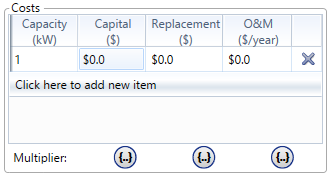
HOMER Pro 3.15

![]()
The Reformer page allows you to enter cost information and manage fuels for a reformer. A reformer generates hydrogen by reforming a hydrocarbon, typically natural gas. Use this page to define the costs and properties of the reformer.
Note: HOMER cannot model a system where a reformer supplies a fuel cell with hydrogen. The only purpose of the reformer is to serve a hydrogen load.
Costs
In the Costs table, enter the reformer cost curve; i.e., the way the cost varies with size. Click the "Click here to add new item" option to add rows to the table.

Note: The capital cost is the initial purchase price, the replacement cost is the cost of replacing the reformer at the end of its lifetime (relevant only if the project lifetime exceeds the reformer lifetime), and the operating and maintenance cost is the annual cost of operating and maintaining the reformer.
Sizes
In the Capacity Optimization table, enter the reformer sizes you want HOMER to consider as it searches for the optimal system. Be sure to include a zero size if you want to consider systems without a reformer.

HOMER uses the information you entered in the Costs table to calculate the costs of each reformer size, interpolating and extrapolating as necessary. You can see the results in the cost curve graph.
Tip: You can also access the values in this table using the Search Space window.
Performance Parameters
The Select Fuel: drop-down menu contains all the fuels stored in your Component Library. Choose the appropriate fuel from this list. To see the properties of the selected fuel on the Fuel Resource page, click the Manage Fuels button.

You can create a new fuel type by clicking the New button. The new fuel type is added to your Component Library. You can also remove a fuel type from the Component Library by clicking the Delete button. Note that additions and deletions from the Component Library are canceled if you close the Reformer Inputs window with the Cancel button.
Economic Parameters
|
Variable |
Description |
|
Diesel Fuel Price |
The cost of diesel fuel, in $/L |
|
The efficiency with which the reformer converts the fuel to hydrogen, in % |
|
|
Lifetime |
The number of years the reformer will last |
|
Delivery Cost |
The cost of transporting the hydrogen produced by the reformer to the site of use, in $/kg/km |
Tip: You do not need to input cost data if you do not want to consider delivery cost. HOMER assumes the delivery cost to be zero if no delivery cost is entered.
Note: To the right of each numerical input is a
sensitivity button ( ) that allows you to do a sensitivity analysis on that variable. For more
information, see Why Would I Do a
Sensitivity Analysis?
) that allows you to do a sensitivity analysis on that variable. For more
information, see Why Would I Do a
Sensitivity Analysis?
